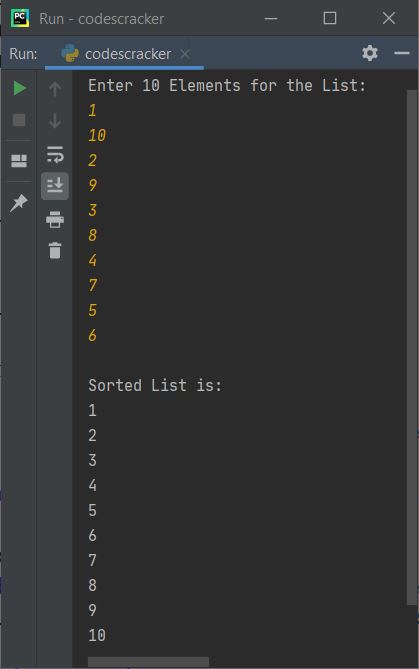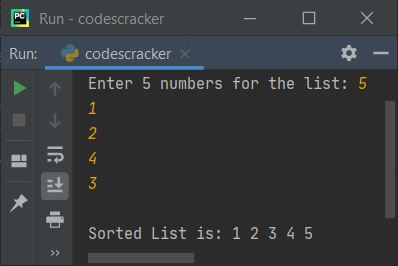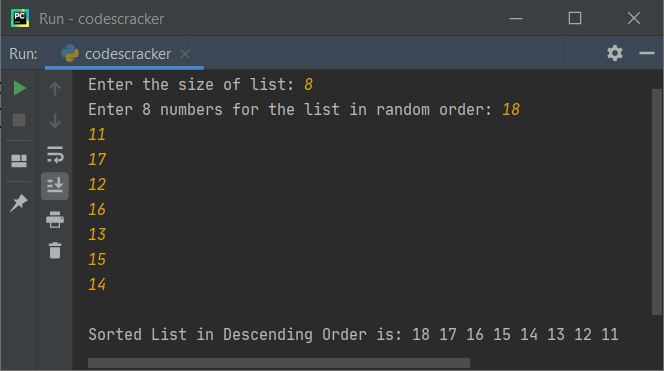- Python Basic Programs
- Python Program Examples
- Python Print Hello World
- Python Get Input from User
- Python Add Two Numbers
- Add Subtract Multiply Divide
- Python Check Even or Odd
- Python Check Prime or Not
- Python Check Alphabet or Not
- Python Check Vowel or Not
- Python Check Leap Year or Not
- Check Reverse equal Original
- Check Positive Negative Zero
- Python Check Armstrong or Not
- Python Check Palindrome or Not
- Python Check Perfect Number
- Python Find Reverse of Number
- Python Count Digits in Number
- Python Add Digits of Number
- Sum of First and Last Digits
- Python Product of Mid Digits
- Sum of Squares of Digits
- Interchange Digits of Number
- Python Sum of n Numbers
- Python Print ASCII Values
- Python Swap Two Numbers
- Python Swap Two Variables
- Python Fahrenheit to Celsius
- Python Celsius to Fahrenheit
- Python Display Calendar
- Python Days into Years, Weeks
- Find Largest of Two Number
- Find Largest of Three Number
- Python Print Fibonacci Series
- Generate Armstrong Numbers
- Python Make Simple Calculator
- Python Add Binary Numbers
- Binary Number Multiplication
- Python Mathematical Programs
- Find Sum of Natural Numbers
- Find Average of n Numbers
- Python Print Multiplication Table
- Print Table using Recursion
- Python Find Average Percentage
- Python Find Grade of Student
- Find Square Root of Number
- Python Print Prime Numbers
- Find Numbers Divisible by
- Python Find Factors of Number
- Python Find Factorial of a Number
- Python Find HCF & LCM
- Python Kilometres to Miles
- Python Find Area of Square
- Python Find Area of Rectangle
- Python Find Area of Triangle
- Python Find Area of Circle
- Python Find Perimeter of Square
- Find Perimeter of Rectangle
- Python Find Perimeter of Triangle
- Find Circumference of Circle
- Python Simple Interest
- Python Solve Quadratic Equation
- Python Different Set of Operations
- Python Display Powers of 2
- Python Find nCr & nPr
- Python Pattern Programs
- Python Print Pattern Programs
- Python Print Diamond Pattern
- Python Print Floyd's Triangle
- Python Print Pascal's Triangle
- Python List Programs
- Python Count Even/Odd in List
- Python Positive/Negative in List
- Python Even Numbers in List
- Python Odd Numbers in List
- Python Sum of Elements in List
- Sum of Odd/Even Numbers
- Python Element at Even Position
- Python Element at Odd Position
- Python Search Element in List
- Python Largest Number in List
- Python Smallest Number in List
- Python Second Largest in List
- Python Second Smallest in List
- Python Insert Element in List
- Python Delete Element from List
- Python Multiply Numbers in List
- Swap Two Elements in List
- Python 1D Array Program
- Python Linear Search
- Python Binary Search
- Python Insertion Sort
- Python Bubble Sort
- Python Selection Sort
- Remove Duplicates from List
- Python Reverse a List
- Python Merge Two List
- Python Copy a List
- Python Conversion Programs
- Python Decimal to Binary
- Python Decimal to Octal
- Python Decimal to Hexadecimal
- Python Binary to Decimal
- Python Binary to Octal
- Python Binary to Hexadecimal
- Python Octal to Decimal
- Python Octal to Binary
- Python Octal to Hexadecimal
- Python Hexadecimal to Decimal
- Python Hexadecimal to Binary
- Python Hexadecimal to Octal
- Python Matrix Programs
- Python Add Two Matrices
- Python Subtract Two Matrices
- Python Transpose Matrix
- Python Multiply Matrices
- Python String Programs
- Python Print String
- Python Find Length of String
- Python Compare Two Strings
- Python Copy String
- Python Concatenate String
- Python Reverse a String
- Python Swap Two Strings
- Python Uppercase to Lowercase
- Python Lowercase to Uppercase
- Python Check Substring in String
- Python Count Character in String
- Count Repeated Characters
- Python Count Word in Sentence
- Python Count Each Vowels
- Python Capitalize Character
- Python Capitalize Word in String
- Python Smallest/Largest Word
- Remove Spaces from String
- Remove Duplicate Character
- Remove Vowels from String
- Remove Punctuation from String
- Python Remove Word in String
- Python Remove Duplicate Words
- WhiteSpace to Hyphens
- Replace Vowels with Character
- Replace Character in String
- Python Sort String in Alphabetical
- Sort Word in Alphabetical Order
- Extract Number from String
- Python Check Anagram Strings
- Python File Programs
- Python Read a File
- Python Write to File
- Python Append Text to File
- Python Copy Files
- Python Merge Two Files
- Python Counts Characters in File
- Python Count Words in File
- Python File Content in Reverse
- Python Lines Contains String
- Python Delete Line from File
- Python Capitalize Word in File
- Python Replace Text in File
- Replace Specific Line in File
- Python Find Size of File
- Python List Files in Directory
- Python Delete Files
- Python Misc Programs
- Python Reverse a Tuple
- Python Merge Two Dictionary
- Python bytes to String
- Python bytearray to String
- Generate Random Numbers
- Python Print Address of Variable
- Python Print Date and Time
- Python Get IP Address
- Python Shutdown/Restart PC
- Python Tutorial
- Python Tutorial
Selection Sort Program in Python
This article is created to cover some programs in Python, based on selection sort technique. Here are the list of programs covered in this article:
- Selection sort program based on limited elements in list
- Selection sort program based on n elements
- Selection sort program to sort elements of list in descending order
But before going through these programs, if you're not aware about the algorithm or technique used in selection sort, refer to Selection Sort Algorithm and Example to get every required things about it. Now let's move on and create these selection sort programs.
Selection Sort Program
The question is, write a Python program to sort all elements of a list using selection sort. The program given below is answer to this question:
nums = [] print("Enter 10 Elements for the List: ") for i in range(10): nums.append(int(input())) for i in range(9): chk = 0 small = nums[i] for j in range(i+1, 10): if small > nums[j]: small = nums[j] chk = chk + 1 index = j if chk != 0: temp = nums[i] nums[i] = small nums[index] = temp print("\nSorted List is: ") for i in range(10): print(nums[i])
Here is its sample run. The snapshot given below shows the initial output produced by above Python program:

Now provide the input say 1, 10, 2, 9, 3, 8, 4, 7, 5, 6 as ten randomly ordered elements for the list, and
press ENTER key to sort all these elements in ascending order using selection sort technique.
The snapshot given below shows the output produced by above program after providing exactly same inputs:

Selection Sort based on n Elements
This program allows user to define the size of list along with its elements. So we can say, this is basically the modified version of previous program. Rest of the things are almost similar to previous program.
nums = [] print("Enter the size of list: ", end="") tot = int(input()) print("Enter", tot, "numbers for the list: ", end="") for i in range(tot): nums.append(int(input())) for i in range(tot-1): chk = 0 small = nums[i] for j in range(i+1, tot): if small > nums[j]: small = nums[j] chk = chk + 1 index = j if chk != 0: temp = nums[i] nums[i] = small nums[index] = temp print("\nSorted List is: ", end="") for i in range(tot): print(nums[i], end=" ")
Here is its sample run with user inputs, 5 as size and 5, 1, 2, 4, 3 as five elements:

Selection Sort in Descending Order
To sort list items in descending order using selection sort technique, just replace the following if:
if small > nums[j]:
from above program, that sorts list items in ascending order using selection sort technique, with following if:
if small < nums[j]:
As you can see, only a matter of less than (<) and greater than (>) sign, the whole program gets reversed. Here is the complete version of the program:
nums = [] print("Enter the size of list: ", end="") tot = int(input()) print("Enter", tot, "numbers for the list in random order: ", end="") for i in range(tot): nums.append(int(input())) for i in range(tot-1): chk = 0 small = nums[i] for j in range(i+1, tot): if small < nums[j]: small = nums[j] chk = chk + 1 index = j if chk != 0: temp = nums[i] nums[i] = small nums[index] = temp print("\nSorted List in Descending Order is: ", end="") for i in range(tot): print(nums[i], end=" ")
Here is its sample run with user input, 8 as size and 18, 11, 17, 12, 16, 13, 15, 14 as eight elements or numbers:

« Previous Program Next Program »